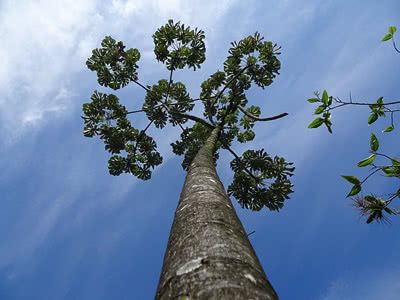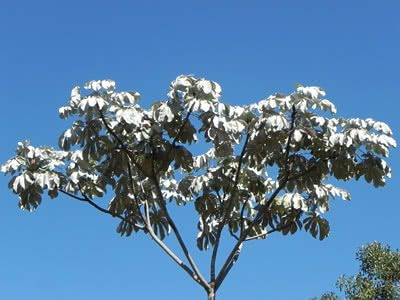The Silverleaf Cecropia (Cecropia hololeuca) is a pioneer tree, native to the Atlantic Forest and known for its ornamental value. It thrives in abundant sunlight. It has been mentioned in the accounts of travelers who journeyed along the Royal Road in the early 19th century. This road, spanning over 1630 kilometers, was built by the Portuguese crown and traverses the states of Minas Gerais, São Paulo, and Rio de Janeiro (Brazil). The Silverleaf Cecropia is found in these states as well as in Bahia and Espírito Santo. As a pioneer species with secondary vegetation, it grows rapidly, reaching heights of up to 12 meters and diameters of 20 to 30 cm. It primarily emerges at the forest’s edge and in natural clearings. Consequently, its wood is soft, and its trunk is hollow, segmented with nodes and internodes akin to bamboo, providing shelter for beneficial Aztec ants. Its canopy branches out irregularly at the top of the trunk, forming an uneven cup.

Apart from its unusual tree form, it showcases large peltate leaves (50 to 60 cm in diameter) resembling spread palms, with 6 to 10 finger-like lobes. These leaves are silver in color due to a dense layer of white hairs on both sides, reflecting sunlight. It blooms multiple times a year, usually in late spring and throughout summer, producing spike-like inflorescences at the highest branches, protected by leaves. The flowers are fragrant but not of significant ornamental value. Its elongated fruits contain numerous seeds and serve as food for various birds and monkeys. Sloths are attracted to its new shoots.

Perfect for large gardens, parks, and squares, the Silverleaf Cecropia stands out in landscaping due to its unique form and rarely seen foliage that contrasts with the surrounding vegetation. It can be used individually, in clusters, or in combination with other species, creating open or dense groves. Avoid planting near buildings, walkways, or parking areas, as natural pruning and occasional falling branches can cause accidents. It’s also an excellent choice for mixed planting in reforestation areas, thanks to its rapid growth and its ability to attract seed-dispersing avifauna.
The wood of the Silverleaf Cecropia is very light, soft, and of low density. It finds use in making floats, rafts, crates, matchsticks, musical instruments, firewood, and charcoal for gunpowder. Its pale fiber, rich in cellulose, is suitable for paper production.
This tree should be cultivated in full sunlight, in well-draining soils, preferably rich in organic matter. It appreciates watering in the first year after planting. It doesn’t tolerate shade or intense cold. It reproduces through seeds from ripe fruits, recognizable by the marks of bird beaks. The fruits should be left to rest in a pile for a few days, then mashed and filtered to separate seeds from pulp. Dry the seeds in the sun and then plant them in bags with prepared, moist substrate, in partial shade. Germination is low and irregular, around 20%, but the seedlings develop rapidly.
